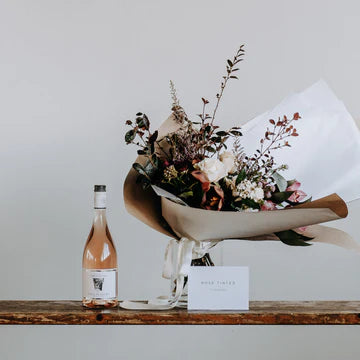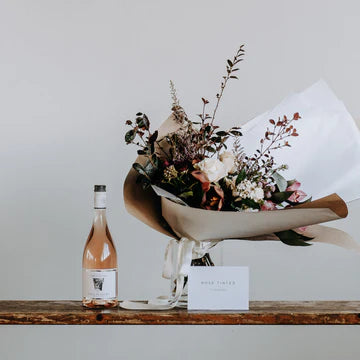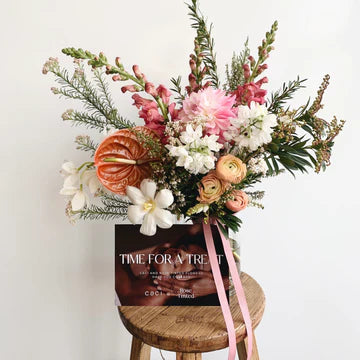Your Seasonal guide to wedding flowers
Whether you’re planning your bridal bouquet or wanting a little pick-me-up to fight the mid-week blues, getting seasonal flowers are always the best way to go. Not only is going seasonal less expensive, but you’ll also be drastically reducing the carbon footprint of your purchase! In spring and summer - the most popular times of the year to get married due to the weather - flowers are abundant. However, many people don’t realise that there is also a large variety of autumn and winter blooms as well, especially if your florist works with local growers - not to mention the lovely berries, herbs, and flowering foliage available all year round. To make it easier for you to discuss the more sustainable floral options with your florist, here is a New Zealand seasonal flower guide for you to peruse.
SPRING
AQUILEGIA

Aquilegia flowers, or more commonly known as granny’s bonnet or columbine, are some of the less well-known blooms used for floral arrangements. The spurred petals of many aquilegia variants add a visual component of interest, whereas the double-flowered hybrid variants are perfect for adding that romantic ruffled look to your arrangement with flowers of a smaller size.
CLEMATIS

Image by Seattle Wholesale Growers Market
Clematis aren’t at the forefront of many people’s minds when they think about the kinds of floral arrangements they’d like at the wedding. However, this beautiful flowering vine is found in many a floral masterpiece. Its availability in numerous shades including white, pink, burgundy, and dark purple means it’s an incredibly versatile flower that can be used to construct any aesthetic you want, and its longevity makes it as practical to use as it is pretty.
CORNFLOWER

Cornflowers are one of those flowers that evolution engineered perfectly for the ‘just-picked’ garden or wildflower bouquet - they strike the stunning balance between wild and formed. The most common cornflower colour is blue, however less common colours such as lighter pinks, lavender, white and dark maroons can also be found.
LILAC

Much-loved members of the olive family, lilacs are a fragrant, stunning option to include in your wedding arrangements. They are known for their iconic purple colouration, but if it’s just the texture you’re in love with, they’re also available in a bridal white.
MANUKA

It’s a prolific scrub-type plant in New Zealand, and definitely one we could be using more in our wedding floral arrangements. Branches of manuka look stunning as bouquet foliage that doesn’t just take the role of ‘filler’ - manuka not only occupies space but steals some of the limelight too. It offsets ruffly flowers like roses with the hardier bristly character, but its white/pink colouration keeps things looking gentle and romantic overall.
NIGELLA

Nigella damascena goes by a few other names, including the whimsical ‘love-in-a-mist’ and the not-so-whimsical ‘devil-in-a-bush’. A member of the buttercup family, this flower most commonly comes in various shades of blue - ‘Blue Midget’, ‘Cambridge Blue’, ‘Oxford Blue’, ‘Dwarf Moody Blue’ - but can also be white, pink, or pale purple.
PEONIES

A regular best-seller in florists worldwide, peonies are gorgeous quintessential wedding flowers that brides can’t seem to resist including in their arrangements. They can be used either when the petals are tight and snug, or when they’re wider and more open for a slightly more relaxed, carefree feel. Available in shades of white, off-white, yellow, and numerous pinks and reds, there’s a shade that would complement any style of bouquet.
POPPIES

Pretty and happy-go-lucky, the charms of poppies as wedding flowers are hard to miss. The most iconic shade would be that of bright red poppies, but these flowers also come in orange, yellow, white, and purple. One shortcoming of these delightful blooms to keep in mind is that they are very short-lived out of water and in warmer temperatures, so your floral designer will have to make any arrangements including poppies soon before their use.
SWEETPEA

A posy of sweetpeas exudes youthful simplicity ideal in wedding bouquets. But these flowers also look fantastic mixed in with other blooms. Their frilly petals come in a rainbow of colours from pastels to vibrant plums, as well as white if you want to opt for that classic bridal palette.
SUMMER
AMARANTHUS

Amaranthus is one of the key players in constructing the perfect cascading bouquet - their trailing, gentle figures evoke a sense of love, overflowing. But they’re not just great for the bridal bouquet - their ‘tails’ of floral clusters draping downwards will add a sense of dimension to any floral arrangement. Make sure to ask your floral designer about ways you could incorporate this plant, especially if you’ve planned a bohemian or rustic wedding with a focus on lush natural aesthetics.
ANTHURIUM

Anthurium, also known by other names such as the tailflower and flamingo flower, are heart-shaped flowers that are particularly great to use in summer wedding floral arrangements as they endure well throughout the day. The spathe (the single leaf-like structure surrounding the ‘tail’ which is called a spadix) comes in different colours - white, pink, and green being popular shades for weddings.
COSMOS

Cosmos are whimsical flowers with daisy-like petals that bring an ethereal charm to arrangements. There are many types of cosmos with distinguishing features like picotee edges, but one of the most sought-after variants for wedding arrangements would be the chocolate cosmos. With a decadent, burgundy hue, delicious sweet scent, and lush, velvety texture, this particular bloom brings so much to the table. Irresistible.
GARDEN ROSES

What flower is more perfect for a bridal bouquet than this enduring symbol of romance? Some brides assume that roses are too cliche for a modern wedding and request for alternative blooms from the get-go, but they’re probably thinking of the kinds available at your nearest dairy. Garden roses have been bred and cultivated to yield lush, ruffly petals that swirl around the centre for an effortlessly romantic look.
SCABIOSA

Scabiosa, also known as a pincushion flower, are cute and quirky blooms that work particularly well in ‘just-picked’ garden bouquets (think bohemian or garden weddings). They do tend to be delicate, however, making them poor candidates for buttonholes (unless you opt for scabiosa pods instead).
TUBEROSE

Tuberose is well known for its fragrance; extracts are frequently used for notes in perfumery. However, their charms extend beyond the olfactory domain - the lovely white flowers are commonly used in wedding arrangements as well as for general floral art compositions. A note of caution if using tuberose is to be mindful of the scents of other flowers in the planned arrangement, as not all smells will mix well.
TWEEDIA

A member of the milkweed family, tweedia are notoriously tricky for floral designers to work with due to the messy sap and irritant effects on sensitive skin. However, the consensus is that these trials are worth it - blue flowers are much rarer to source in the commercial cut flower market, and tweedia come in a variety of stunning shades that could easily work as your ‘something blue’.
AUTUMN
BERRIES

Berries can be an excellent bouquet filler alternative to simple foliage - they provide texture, colour, and unique form that makes them visually striking accents. There are many many different types of berries including (but not limited to) hypericum, pepper, berzelia, viburnum, elderberries, snowberries, and tallow berries… so finding berries that will complement and enhance the beauty of your blooms will be incredibly easy.
DAHLIA

In the language of flowers, dahlias symbolise dignity. They are the perfect way to add some colour to wedding arrangements. They come in all manner of colours, as well as shapes (there are 14 different ‘groups’ of dahlia flowers identified by the Royal Horticultural Society). They do tend to be a bit more delicate with a tendency to bruise if not handled carefully.
ECHINACEA

Echinacea is a group of plants belonging to the daisy family. They’re commonly called coneflowers, but the name echinacea originates from the Greek word for hedgehog due to the spiky look/feel of the flower heads. Florists often remove the petals from echinacea specifically so that the heads can be used in arrangements such as bouquets, boutonnieres, and even table decor.
MICROMYRTUS

Endemic to Australia, micromyrtus plants are shrubs that often have little, perfectly-formed flowers like in the image above. They’re a graceful addition to provide texture and variation in size to floral arrangements.
PROTEA

YARROW/ACHILLEA

Achillea millefolium goes by many names including yarrow, plumajillo (‘little feather’), and thousand-leaf. It’s a useful plant that has many properties such as wound healing for which it has been used in the past, but one of our favourite uses is as a filler flower in wedding bouquets.
WINTER
ANEMONES

The anemone is a wedding bouquet favourite, and it’s easy to see why. The relaxed, flowy petals feel romantic; the structured black centres add an element of the dramatic. The most popular variety tends to be the white petalled anemone with black centres (so crisp and especially perfect for monochromatic wedding palettes), but they do come in a variety of hues including red, pink, purple, and blue.
FLOWERING PIERIS

Pieris is a little bit like amaranthus in that it will add some textural diversity and a more flowy look to your floral arrangements. The trailing clusters of flowers tend to be shorter with pieris, but the flowers have a softer look making it particularly suitable for complementing other flowers in classically romantic looking arrangements.
HELLEBORES

Hellebores are beautiful blooms that come in numerous colours including (but not limited to): black, purple, pink, white, and green. Many types will have unique features like speckling, veining, or variegation which adds points of interest to any arrangement. They can be used for either traditional or more modern styles of bouquets, but also look great when woven into the bride or bridesmaids’ hairstyle.
KING PROTEA

The sheer size and architectural intrigue of the king protea makes it a statement bloom like no other. Sufficiently striking to feature in a single-stem bouquet, but versatile enough to work with all manner of more conventional blooms, these exotic ‘sugarbush’ flowers of South African origin are perfect for the bridal or bridesmaid bouquets.
MAGNOLIA

Magnolia is the floral paragon of elegance. Their luxuriously large petals make them captivating, but not visually overpowering - depending on the arrangement, magnolia flowers can either blend in or stand out. If you have a particularly stunning bloom, a single stem magnolia bouquet will look stunning but unfussy in wedding photography sessions. If you are considering magnolia, don’t forget about their leaves - with a distinct, structured personality they are great fillers in arrangements, and individual leaves can be used as reception table place cards if you add some gold calligraphy.
RANUNCULUS







Leave a comment